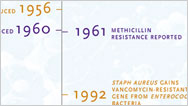Was It Weaponized?
- Posted 04.01.09
- NOVA scienceNOW
Were the anthrax spores used in the 2001 terrorist attacks specially engineered to better disperse through the air? As this video extra shows, to find out, scientists at Sandia National Laboratories peered closely at the spores with electron microscopes and then reported their perhaps surprising findings to the FBI.
Transcript
Was It Weaponized?
Posted: April 1, 2009
NARRATOR: Silica, a compound used to make anthrax disperse, had shown up in the attack letters, but coating anthrax spores with silica requires a sophisticated weapons program. Alarmed by the possibility of state-sponsored terrorism, the FBI sent the evidence to New Mexico where Sandia National Laboratories could analyze it. Joseph Michael studied the attack spores with the lab's electron microscopes.
JOSEPH MICHAEL (Sandia National Laboratories): The modern electron microscopes can image now things as small as a couple nanometers, and a nanometer – this is my favorite analogy – a nanometer is if you look at your fingernail and blink your eyes, your fingernail just grew a nanometer.
NARRATOR: Fortunately, an anthrax spore is far larger, but because Michael only worked with atoms, he needed a crash course, learning what anthrax looked like before and after being weaponized.
JOSEPH MICHAEL: The weaponized anthrax appeared to be coated with a fine coating of silica nano-particles. It looks almost fuzzy or linty, like in the microscope.
NARRATOR: But that's not how the anthrax used in the attacks looked. So where was the silica the FBI had detected?
PAUL KOTULA (Sandia National Laboratories): The silicon turns out to be on the internal structure of the spore. So these bright two lines in here are actually where the silicon oxide is.
NARRATOR: Silica naturally absorbed into a spore would have no effect on how it dispersed.
PAUL KOTULA: We had to tell the FBI we didn't think this anthrax had been weaponized intentionally, and all signs pointed to it coming from a source within the United States.
Credits
- Produced for NOVA scienceNOW by
- Sarah Holt
- Video
- (all) © WGBH Educational Foundation
Related Links
-

Anthrax Investigation
The new science of microbial forensics reveals the source of the anthrax used in the deadly attacks of 2001.
-

Anthrax Investigation: Q&A
Paul Keim of Northern Arizona University answers questions about microbial forensics, global plagues, and more.
-

History of Biowarfare
Once, plague-infested corpses were catapulted over castle walls. Today's version might be an engineered "superplague."
-

Arms Race With a Superbug
Certain microbes evolve defenses against every antibiotic we throw at them. Staph aureus is a sobering case in point.



